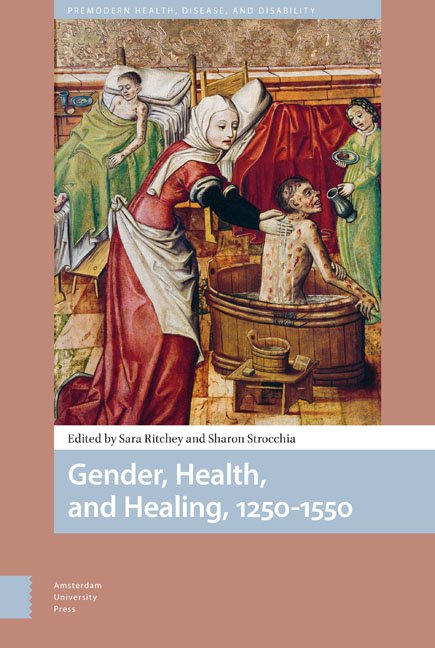Book contents
- Frontmatter
- Contents
- List of Figures and Tables
- Acknowledgments
- Abbreviations
- Introduction: Gendering Medieval Health and Healing: New Sources, New Perspectives
- Part 1 Sources of Religious Healing
- 1 Caring by the Hours: The Psalter as a Gendered Healthcare Technology
- 2 Female Saints as Agents of Female Healing: Gendered Practices and Patronage in the Cult of St. Cunigunde
- Part 2 Producing and Transmitting Medical Knowledge
- 3 Blood, Milk, and Breastbleeding: The Humoral Economy of Women's Bodies in Medieval Medicine
- 4 Care of the Breast in the Late Middle Ages: The Tractatus de passionibus mamillarum
- 5 Household Medicine for a Renaissance Court: Caterina Sforza's Ricettario Reconsidered
- 6 Understanding/Controlling the Female Body in Ten Recipes: Print and the Dissemination of Medical Knowledge about Women in the Early Sixteenth Century
- Part 3 Infirmity and Care
- 7 Ubi non est mulier, ingemiscit egens?: Gendered Perceptions of Care from the Thirteenth to Sixteenth Centuries
- 8 Domestic Care in the Sixteenth Century: Expectations, Experiences, and Practices from a Gendered Perspective
- 9 Bathtubs as a Healing Approach in Fifteenth-Century Ottoman Medicine
- Part 4 (In)fertility and Reproduction
- 10 Gender, Old Age, and the Infertile Body in Medieval Medicine
- 11 Gender Segregation and the Possibility of Arabo-Galenic Gynecological Practice in the Medieval Islamic World
- Afterword: Healing Women and Women Healers
- Contributors
- Index
5 - Household Medicine for a Renaissance Court: Caterina Sforza's Ricettario Reconsidered
Published online by Cambridge University Press: 23 June 2021
- Frontmatter
- Contents
- List of Figures and Tables
- Acknowledgments
- Abbreviations
- Introduction: Gendering Medieval Health and Healing: New Sources, New Perspectives
- Part 1 Sources of Religious Healing
- 1 Caring by the Hours: The Psalter as a Gendered Healthcare Technology
- 2 Female Saints as Agents of Female Healing: Gendered Practices and Patronage in the Cult of St. Cunigunde
- Part 2 Producing and Transmitting Medical Knowledge
- 3 Blood, Milk, and Breastbleeding: The Humoral Economy of Women's Bodies in Medieval Medicine
- 4 Care of the Breast in the Late Middle Ages: The Tractatus de passionibus mamillarum
- 5 Household Medicine for a Renaissance Court: Caterina Sforza's Ricettario Reconsidered
- 6 Understanding/Controlling the Female Body in Ten Recipes: Print and the Dissemination of Medical Knowledge about Women in the Early Sixteenth Century
- Part 3 Infirmity and Care
- 7 Ubi non est mulier, ingemiscit egens?: Gendered Perceptions of Care from the Thirteenth to Sixteenth Centuries
- 8 Domestic Care in the Sixteenth Century: Expectations, Experiences, and Practices from a Gendered Perspective
- 9 Bathtubs as a Healing Approach in Fifteenth-Century Ottoman Medicine
- Part 4 (In)fertility and Reproduction
- 10 Gender, Old Age, and the Infertile Body in Medieval Medicine
- 11 Gender Segregation and the Possibility of Arabo-Galenic Gynecological Practice in the Medieval Islamic World
- Afterword: Healing Women and Women Healers
- Contributors
- Index
Summary
Abstract
Household recipe books were the most prevalent form of women's authoritative medical writing in Renaissance Europe. Among the most significant female-authored collections from fifteenth-century Italy was that of Caterina Sforza (1463-1509), Countess of Imola and Forlì. Two recently discovered manuscripts shed new light on her creative praxis and the practical knowledge she collected, developed, and tested. We argue that Caterina's vast miscellany of ‘secrets’ must be read intentionally within the context of a household economy writ large, simultaneously serving the health needs and political objectives of a Renaissance court. These discoveries highlight the authority of experiential knowledge within the domestic realm and beyond. Since the manuscripts were subjected to censorship, we interrogate the later reclassification of some of Caterina's authoritative knowledge as heterodox.
Keywords: recipe books, pharmacy, cosmetics, experimentation, magic, censorship
The study of household recipe books in late medieval and early modern Europe has sparked enormous interest in recent years. These troves of practical knowledge were the most common form of women's medical writing in Renaissance Europe, often providing the textual basis for female medical authority. Recent studies have shown that recipe books played a key role in the practice of household medicine, which remained the primary mode of caring for the sick until the nineteenth century. Often organized in eclectic ways, recipe books offered valuable guides to healing as well as good household management. Bundled together in these compendia were a wide variety of recipes ranging from medicaments, cosmetics, and culinary secrets to instructions for making ordinary household products such as ink, soap, and stain remover. The impressive range of activities encompassed by recipe collections testifies to the complex skills needed to govern an early modern household. In the sometimes idiosyncratic ways they curated their collections, female householders found opportunities to display both their prudence and intellectual interests.
As indicators of their authors’ active pursuits, the recipe books compiled by women also testify to female engagement with early modern cultures of experimentation. It was not uncommon for affluent women to try out medical recipes in order to improve their smell, texture, taste, and shelf life, or to adapt them in line with available ingredients.
- Type
- Chapter
- Information
- Gender, Health, and Healing, 1250–1550 , pp. 139 - 166Publisher: Amsterdam University PressPrint publication year: 2020



